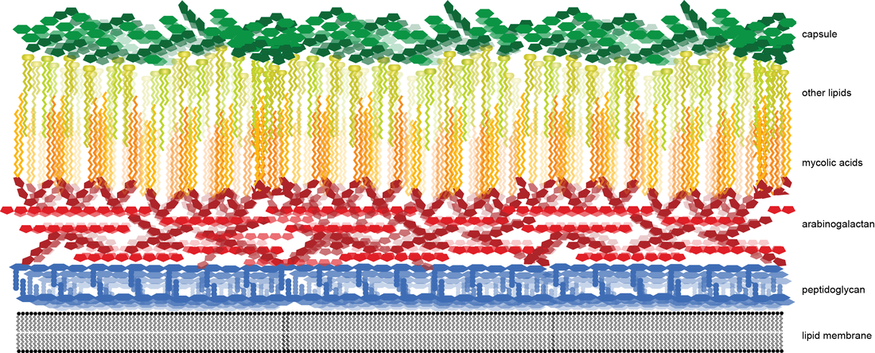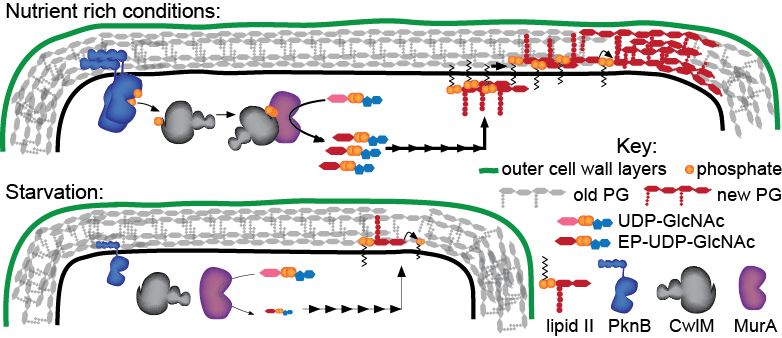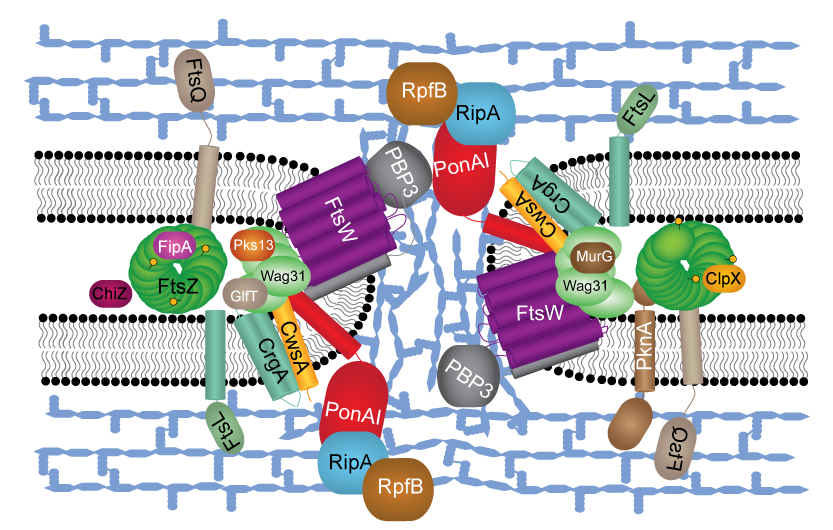|
How does the cell surface protect cells from environmental assaults, while still permitting the uptake of nutrients and allowing for cell growth and division?
This is a fundamental question of biology that all organisms must grapple with in their own way. In bacteria, the answers to this question have implications for infection, immunity and antibiotic treatment. We use forward and reverse genetics, biochemistry and microscopy to address this and related questions. |
The mycobacterial cell wall (above) is thick and multi-layered - it's easy to see how it protects the cell. But this structure must be permeable to allow food to get into the cell; under certain conditions we can sneak some antibiotics in as well. In addition, this structure must be expanded to allow for cell growth and then effectively split in half at each cell division event - how does all this happen without compromising the protective role of the cell wall?
Projects in the lab:
1. How is the amount of cell wall precursors regulated under different growth conditions? And how does this regulation contribute to antibiotic tolerance in stress?
One important way to regulate the cell wall is to regulate the production of the precursor molecules that are made in the cytoplasm and then exported into the periplasm for assembly onto the wall. In nutrient-rich conditions, a lot of these precursors are required because the cell is actively growing. In starvation or stresses that limit cell growth, the cell is better off if it can turn down the production of these precursors, which are no longer needed. We are working on understanding a regulatory system that controls the production of peptidoglycan precursors. In this system, the regulatory protein CwlM helps to stimulate the activity of the precursor enzyme MurA. When CwlM is phosphorylated, MurA gets turned on and peptidoglycan precursors are made. When CwlM is dephosphorylated, MurA and peptidoglycan synthesis get turned off, the cell stops growing and becomes more tolerant to antibiotics. We are trying to understand the signals that cue these regulatory events, and identify and characterize other players in this regulatory system. We are also interested in identifying other regulatory systems that must exist to control the production of other kinds of cell wall precursors. Below is a cartoon model of the CwlM/ MurA regulatory system.
2. How does the cell wall expand and then split during cell growth and division? How is this process changed under stress?
Expansion of the cell wall requires that bonds in the existing cell wall be broken in order to make room for insertion of new cell wall precursors. Cell division requires that the cell wall assembly machinery switch directions in order to build wall orthogonal to the direction of growth. How is all of this complex chemistry performed while maintaining the protective function of the wall? We are studying the enzymes that do the actual work of building the cell wall as well as their essential regulators, which ensure that the wall is not breached during this work. We have identified a number of novel cell division and growth factors and are working to understand their functions. We are especially interested in trying to understand how all this complex chemistry and regulation changes under conditions of stress, when the cell wall becomes thicker and less permeable to antibiotics. Below is a cartoon of some of the proteins involved in cell septation. We are trying to fill this picture out more, and understand better how these proteins interact with each other.
Proudly powered by Weebly



